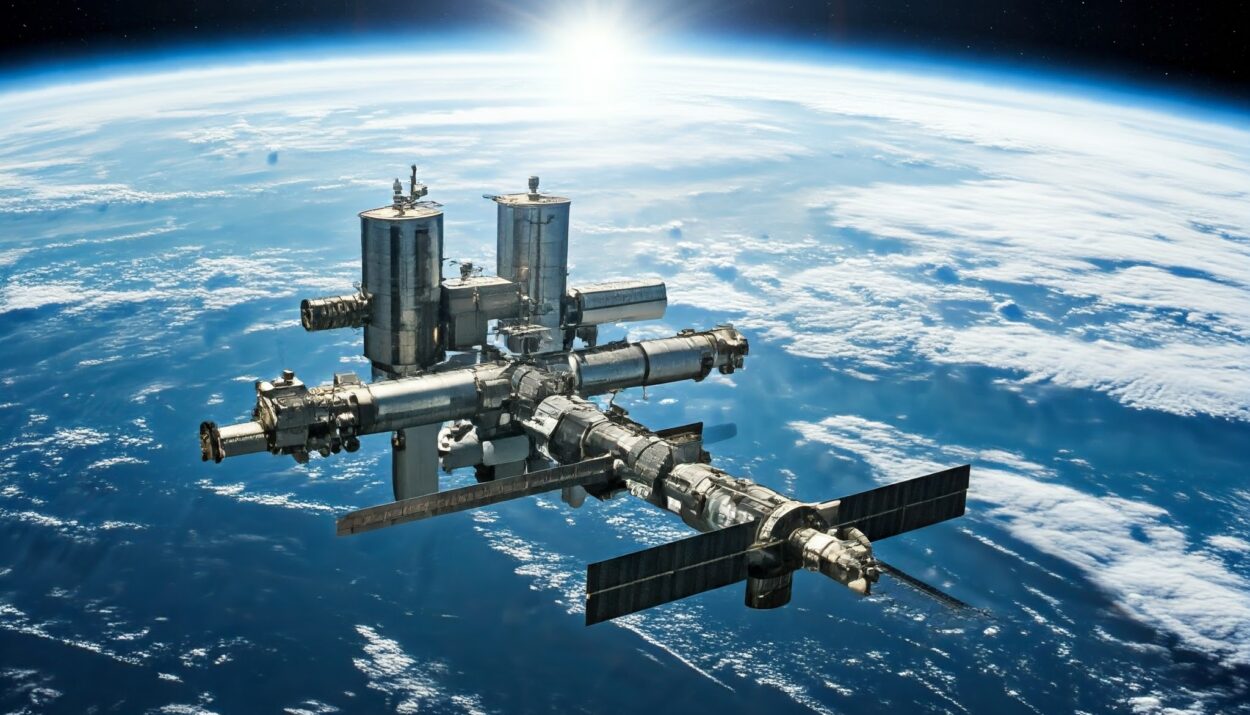Curious about life beyond Earth? The International Space Station (ISS) offers a captivating glimpse into the universe, orbiting our planet at a speed of 28,000 kilometers per hour. As a cutting-edge research hub, the ISS is crucial in advancing science and technology while sparking wonder and excitement worldwide. Whether you’re passionate about space, a student interested in STEM, or simply fascinated by cosmic exploration, the ISS represents a remarkable feat of human achievement. Dive into the extraordinary world of the ISS with us and discover the incredible stories and innovations it brings to light!

Exploring the Wonders of the International Space Station (ISS): A Comprehensive Overview
The International Space Station (ISS) is a pinnacle of human engineering and international collaboration, orbiting Earth at an astonishing speed of about 28,000 kilometers per hour. As a hub for scientific research and technological advancement, the ISS not only serves as a microgravity laboratory but also exemplifies global teamwork in space exploration. This article delves into the ISS’s origins, daily operations, scientific achievements, technological innovations, recent updates, and future outlook.
1. Origins and Development of the ISS
| Genesis of the ISS | The ISS emerged from a groundbreaking international partnership involving NASA (United States), Roscosmos (Russia), ESA (Europe), JAXA (Japan), and CSA (Canada). Launched in 1998, the ISS was envisioned as a modular space station, combining resources and expertise from multiple nations to advance our understanding of space. This collaboration aimed to create a versatile platform for research and experimentation in low Earth orbit. |
| Construction Milestones | The construction of the ISS was an intricate process. It commenced with Russia’s deployment of the Zarya module in 1998. Subsequent years saw the addition of other key modules, such as the U.S. Destiny Laboratory, the European Columbus Laboratory, and the Japanese Kibo Laboratory. Solar panels and docking ports were also integrated, allowing the ISS to accommodate various scientific experiments and international teams. |
| Contributions from Partner Nations | The ISS’s success is a testament to the contributions of several space agencies. NASA provided crucial infrastructure and scientific modules. Roscosmos contributed propulsion and docking systems. ESA, JAXA, and CSA offered specialized laboratories and advanced technology. This international effort highlights the effectiveness of global partnerships in achieving complex space missions. |
2. Life and Work on the ISS
Adapting to Microgravity
Life aboard the ISS requires adjustment to a microgravity environment, where everything floats. Astronauts use Velcro strips and bungee cords to keep their belongings and themselves secure. Daily activities, including eating, sleeping, and personal care, are adapted to this weightless setting, presenting both challenges and opportunities.
Daily Schedule
Astronauts on the ISS follow a structured schedule to ensure productivity and maintain health. Their day begins with physical exercise to combat muscle atrophy and bone loss caused by microgravity. The rest of their day includes conducting experiments, performing maintenance, and staying in touch with mission control. This regimen supports both the ISS’s research objectives and the crew’s overall well-being.
Psychological and Social Aspects
The confined environment of the ISS presents psychological and social challenges. Crew members must navigate the stresses of isolation and work closely within a limited space. To support mental health, astronauts have access to recreational activities, such as watching movies and making video calls with family. These measures help manage the effects of extended confinement and isolation.
3. Research and Scientific Discoveries

Microgravity Research
The ISS offers a unique environment for studying the effects of microgravity on various phenomena. Researchers investigate how fluids and materials behave in space, leading to advancements in technology and materials science. These experiments contribute to important breakthroughs in fundamental physics and chemistry that cannot be replicated on Earth.
Health and Biomedical Research
The ISS also serves as a laboratory for examining the impact of spaceflight on human health. Scientists study changes in muscle mass, bone density, and cardiovascular health due to prolonged microgravity exposure. This research is essential for preparing for future deep-space missions and improving astronauts’ health.
Earth Observation and Environmental Monitoring
From its orbit, the ISS provides valuable data on Earth’s environment and monitors natural disasters. Astronauts capture images of events like hurricanes and wildfires, enhancing our understanding of climate change and environmental shifts. These observations support scientific research and aid in disaster response.
4. Technological Innovations and Achievements
| Advances in Space Technology | The ISS has been instrumental in developing and testing new space technologies. Innovations include advanced life support systems, robotics, and docking mechanisms. For instance, the Canadarm2 robotic arm assists with satellite repairs and module installations. These technologies are critical for future space missions and have practical applications on Earth. |
| International Technological Collaboration | The ISS exemplifies the benefits of international technological collaboration. By combining expertise and resources, partner nations have developed cutting-edge technologies that might not have been possible independently. This collaboration fosters innovation and strengthens global partnerships in space exploration. |
5. Future Prospects of the ISS and Beyond
| Upcoming Missions and Upgrades | The ISS is continuously evolving with ongoing missions and planned upgrades. Recent efforts include installing new research modules and enhancing existing systems to broaden the station’s research capabilities. These upgrades aim to support new scientific endeavors and ensure the ISS remains a leading space research platform. |
| Shift Toward Commercial Space Stations | As the ISS nears the end of its planned operational life, there is growing interest in commercial space stations. NASA and other space agencies are exploring partnerships with private companies to develop new space habitats. These commercial stations could continue to offer research opportunities and space tourism, extending the ISS’s legacy. |
| Preparing for Deep Space Exploration | The ISS plays a crucial role in preparing for future deep-space missions, including trips to Mars. Research conducted on the ISS helps address the challenges of long-duration spaceflight and develop necessary technologies. Insights gained from the ISS are vital for the success of future exploration missions. |
6. Recent Developments and Updates
| Advances in Recycling Technologies | Recent advancements on the ISS include progress in recycling technologies. In 2023, new systems were tested for more efficient air and water recycling. These improvements are essential for sustainable long-term space missions and future space habitats. |
| International Crew Exchange | The ISS recently welcomed new crew members from ESA and JAXA, reflecting ongoing global collaboration. These exchanges bring fresh expertise and perspectives, ensuring diverse scientific experiments and cultural interactions on the station. |
| Private Sector Involvement | Private companies have increasingly supported the ISS, with SpaceX and Boeing playing significant roles in transporting cargo and astronauts. NASA’s efforts to involve the private sector are paving the way for new commercial space stations and research platforms. |
| Progress in Space Tourism | Space tourism has made strides, with recent missions including private astronauts visiting the ISS. These developments mark a significant step toward the commercialization of space travel and contribute to the expanding space economy. |
7. Public Engagement and Opportunities
Educational Resources and Outreach
The ISS offers a range of educational resources for students and educators. Interactive tools, virtual tours, and live Q&A sessions with astronauts provide valuable learning opportunities. Educational programs are designed to inspire students and foster interest in STEM fields.
Social Media and Public Engagement
Stay connected with the ISS through its social media channels for updates, images, and videos. The ISS’s social media presence offers a behind-the-scenes look at life in space and opportunities to engage with the space community.
Citizen Science Projects
Participate in citizen science projects related to space exploration. Public initiatives invite contributions such as analyzing data and observing celestial events, offering a hands-on way to engage with scientific research and support space exploration efforts.

Conclusion
The International Space Station (ISS) represents a landmark achievement in human ingenuity and international cooperation. Its ongoing advancements in research, technology, and global collaboration underscore its crucial role in expanding our knowledge of space. Recent developments, including innovations and increased private sector involvement, highlight the ISS’s significance for future space missions. As the ISS continues to evolve, it remains a cornerstone of space research, paving the way for future exploration and setting a benchmark for global achievements in space
Read more about space explorations here.
Related Post:










